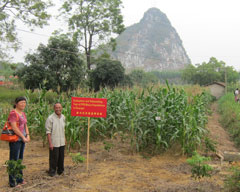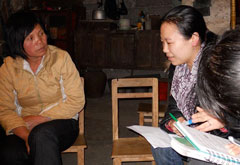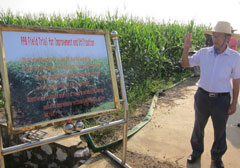
Gender issues in food and farming
Example 2. Participatory plant breeding and agro-ecological farming in SW China
by Janice Jiggins
Two Chinese researchers Jingsong Li of Zhejiang University, Hangzhou, and Yiching Song, at the Chinese Academy of Agricultural Sciences in Beijing, have been working for almost 15 years now in Guangxi in south-west China. First of all Yiching found during her own Ph.D. studies that women farmers up in the mountainous regions of the south-west had developed the capability of producing hybrid maize. She documented how they did this and she found that they were also able to refresh, that is keep productive, their traditional land races. For instance, they had selected a variety of maize released from the agricultural research system and hybridised it with one of their own traditional varieties. She was very intrigued by this and began working with the Maize Research Institute in south-west China, working with men and women farmers to help them develop their agricultures but also to conserve this wonderful genetic material. The maize scientists were particularly keen to see the traditional open pollinated varieties maintained in production, and thus evolving under changing conditions, recognizing that they probably were going to need this material to meet the challenges to productivity and food security under climate change.
So they began to establish working groups of scientists, local officials, extension agents and groups of men and women farmers, first of all in a limited number of villages, and then in a larger number of villages and neighbouring provinces, to do two things. One was to help farmers themselves develop hybrids and improved traditional varieties that are pollinated through open exchange of material. And secondly, they wanted to work out how they could work with farmers so that farmers themselves continue to see a value in conserving some of their traditional land races of their main crops. Could farmers obtain a value on them in the marketplace? Would this provde a sufficient incentive to conserve these varieties?
They have had one locally-produced farmer-based maize hybrid registered for sale and released through the formal system, and have developed a new contract-based agreement, together with the M aize Rice R esearch Institute, to allocate the rights to and profits from seed sales of both the registered variety and improved seeds released for local sale. Local farmers’ groups made up of seed enthusiasts are gaining a new income by producing named and labeled improved seeds.
Further, some of the farmers’ groups working with the researchers and scientists on variety development and conservation, have developed a link with an entrepreneur in a nearby town who was very interested in creating a restaurant chain, selling food, drinks, and products made from the local traditional varieties. A kind of community supported agriculture. He opened the first restaurant, that did extremely well, supported by a weekly flow of produce from contracted farmers’ groups (mainly women farmers). The chain is expanding, providing increasing opportunities to more and more farmers. This example really shows what can be done with patience and collaboration between dedicated people who are prepared to look at gender issues, work with both men and women farmers, and who can figure out how to make new arrangements that support production, livelihood and conservation values.
You can see a film about the project here
Further reading
Song, Yiching (1998) ‘New’ seed in ‘old’ China: impact of CIMMYT collaborative programme on maize breeding in south-western China. Published Ph.D thesis. Wageningen. Wageningen University.
Li, Jingsong (2012) Inducing multi-level institutional change through participatory plant breeding in southwest China. Published Ph.D thesis, Wageningen, Wageningen University.
Photos



